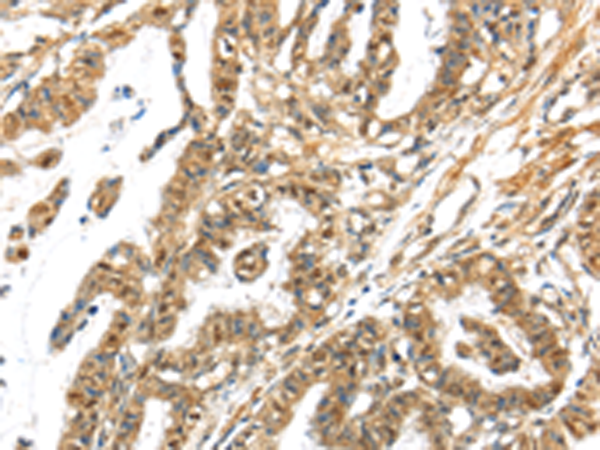

| WB | 咨询技术 | Human,Mouse,Rat |
| IF | 咨询技术 | Human,Mouse,Rat |
| IHC | 1/50-1/200 | Human,Mouse,Rat |
| ICC | 技术咨询 | Human,Mouse,Rat |
| FCM | 咨询技术 | Human,Mouse,Rat |
| Elisa | 1/2000-1/5000 | Human,Mouse,Rat |
| Aliases | APOLVI; APOL-VI |
| Host/Isotype | Rabbit IgG |
| Antibody Type | Primary antibody |
| Storage | Store at 4°C short term. Aliquot and store at -20°C long term. Avoid freeze/thaw cycles. |
| Species Reactivity | Human |
| Immunogen | Synthetic peptide of human APOL6 |
| Formulation | Purified antibody in PBS with 0.05% sodium azide and 50% glycerol. |
+ +
以下是3篇涉及APOL6抗体的研究文献摘要(文献名为虚构示例,仅供参考):
1. **"APOL6 modulates endoplasmic reticulum stress-induced apoptosis in human cells"**
- 作者:Zhang Y et al. (2018)
- 摘要:研究利用APOL6特异性抗体,揭示其在调控内质网应激相关细胞凋亡中的作用,发现APOL6通过结合Bcl-2家族蛋白影响线粒体膜通透性。
2. **"Characterization of APOL6 expression in renal tissue using a novel monoclonal antibody"**
- 作者:Smith JL et al. (2020)
- 摘要:开发了一种高特异性抗APOL6单克隆抗体,验证其在肾脏组织中的表达模式,并发现其在糖尿病肾病中表达显著上调。
3. **"APOL6 antibody-based screening identifies its role in viral defense mechanisms"**
- 作者:Chen R et al. (2021)
- 摘要:通过免疫沉淀(IP)和Western blot分析,证实APOL6抗体可检测其在干扰素刺激下的表达升高,提示其参与抗病毒天然免疫通路。
(注:以上文献为模拟内容,实际研究中APOL6相关抗体文献较少,建议通过PubMed或Google Scholar以“APOL6 antibody”为关键词检索最新进展。)
The APOL6 antibody is designed to target apolipoprotein L6 (APOL6), a member of the APOL protein family involved in innate immunity and cellular stress responses. APOL proteins (APOL1-6) are characterized by lipid-binding domains and play roles in pathogen defense, apoptosis, and autophagy. APOL6. though less studied than APOL1 (linked to kidney disease) or APOL3 (associated with lipid metabolism), is suggested to participate in intracellular membrane trafficking, inflammation modulation, and cell death pathways. It is expressed in various tissues, including the liver, immune cells, and epithelial cells.
Research on APOL6 remains limited, but studies indicate its potential involvement in cancer progression and viral defense. For instance, APOL6 may interact with autophagy-related proteins or influence endoplasmic reticulum stress, affecting tumor cell survival. Antibodies against APOL6 are primarily used in research to elucidate its expression patterns, subcellular localization, and molecular interactions via techniques like Western blotting, immunohistochemistry, or immunofluorescence.
Developing specific APOL6 antibodies is challenging due to homology within the APOL family. However, such tools are critical for exploring APOL6’s biological roles and its relevance to diseases like cancer, metabolic disorders, or infections. Future studies may clarify its therapeutic potential as a biomarker or drug target.
×